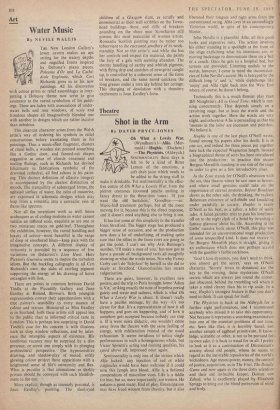Art
Water Music
By NEVILE WALLIS This clear-cut character arises from the Welsh artist's way of ordering his symbols in relief constructions before translating them in his paintings. Thus a music-sheet fragment, clusters of ritual bells, a wooden slat pointed something like a Gothic door, and fanned-out shapes suggestive at once of church ornament and scallop flutings, such as Richards has devised felicitously in fabrications symbolic of the drowned cathedral, all find echoes in his paint- ing. This distinct definition of allusive imagery is accompanied by the clearest distinction of moods. The tranquillity of submerged forms, the agitated surface of water, the calm of moonrise, are expressed in schematic designs which may leap from a romantic into a surrealist vein of flame-like spectres.
Not all the inventions work so well. Some arabesques as of coiling motions in water cannot sustain an inflated scale, exquisite as are one or two miniature traces on gold-leaf. Throughout the exhibition, however, the varied handling and luxury of colour—most beautiful in the range of deep or smothered blues—keep pace with the imaginative concepts. A different display of virtuosity is provided by a sequence of free variations on Delacroix's Lion Hunt. Here Picasso's Guernica seems to inspire the turbulent idiom. But the buckling calligraphy is all Ceri Richards's own, the slabs of swirling pigment supporting the energy of his drawing of horse entangled with lion.
There are points in common between David Tindle at the Piccadilly Gallery and Joan Eardley at Roland, Browse's. Both youngish expressionists convey their apprehensions with a true painter's sensibility to every nuance of colour and texture. Honoured as Miss Eardley is in Scotland, both these artists still appeal less to the public than to informed critical taste in London. This is perhaps less surprising in David Tindle's case for his concern is with illusions such as shop window reflections, and by infer- ence the intangible aspects of existence. His tenebrous vacancy may be surprised by a dim presence, or arrest one simply with its plunging architectural perspective. The hypersensitive drawing, and shadow-play of muted, softly glowing colour project these apparitions with a heightened sense of Iife's anonymity and flux. What is peculiar is that intimations so darkly. private should be conveyed with such blandish- ment to the eye.
More explicit, though as intensely personal, is Joan - Eardley's painting. The slant-eyed children of a Glasgow slum, as scruffy and immemorial as their wall scribbles on the Town- head buildings—these, and cliffs of breakers pounding on the shore near Stonehaven still possess this most masculine of women artists. Romantic Scottish painting may be rather too subservient to the encrusted jewellery of its work- manship. Not so this artist's; and while she has her controls and respect for material, she paints the fury of a gale with seeming abandon. The stormy handling of earthy and whitish pigment, with flying drip and snatches of newsprint caught up, is controlled by a coherent sense of the form of breakers, and the same mood quickens the long grasses under, a torn sky behind her cottage. ,This charging of desolation with a thundery excitement is Joan Eardley's forte.






























 Previous page
Previous page